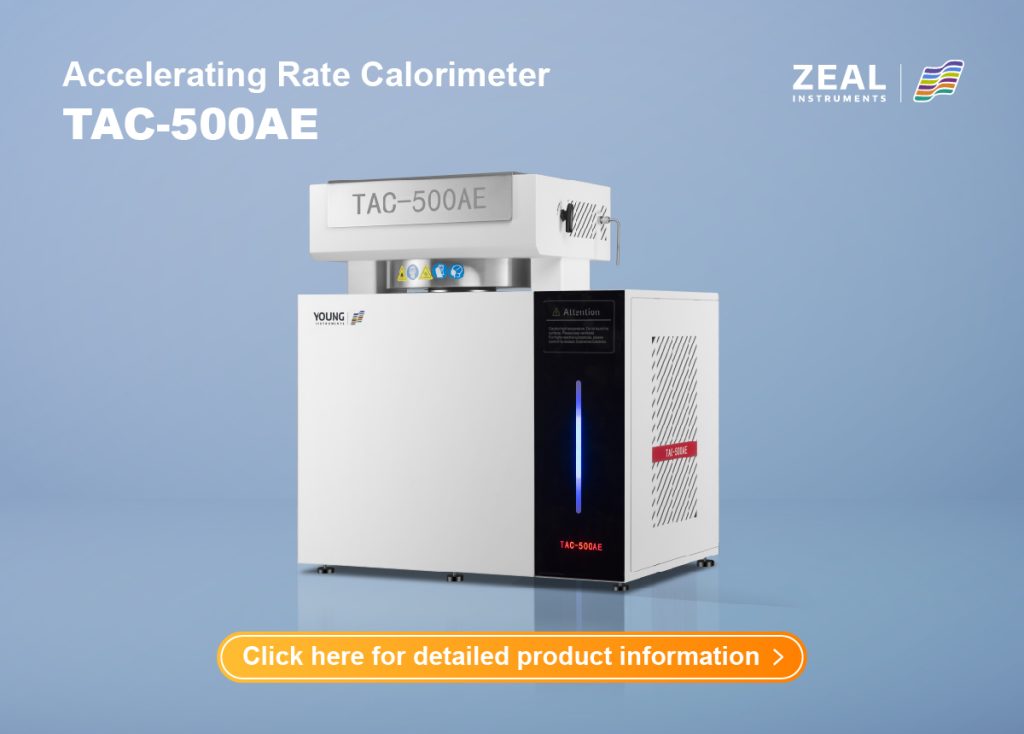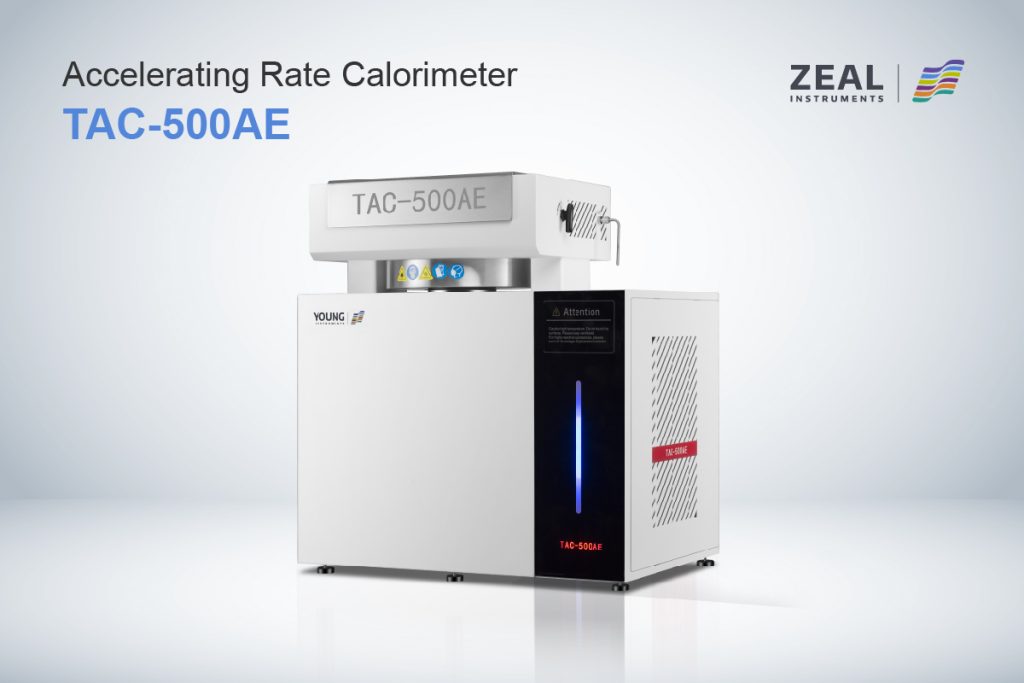Adiabatic Calorimeter for Thermal Safety Testing
An adiabatic calorimeter is an essential instrument for testing energetic materials, batteries, and chemical compounds, providing crucial insights into exothermic reactions, thermal runaway processes, and reaction heat between metastable components. It plays a significant role in the field of process safety, thermal hazard assessment, and material stability. Among the various models, the Accelerating Rate Calorimeter (TAC-500AE) stands out for its versatile features and precise measurements.

This blog explores the principles, applications, and features of the adiabatic calorimeter, with a particular focus on the TAC-500AE, and how it can optimize safety in chemical processes and industrial applications.
Understanding the Working Principle of the Adiabatic Calorimeter
Structure and Components of the Adiabatic Calorimeter
The adiabatic calorimeter’s structure consists of three main components: the adiabatic furnace, the control system, and thermocouples. These elements work together to create a controlled environment where the sample can undergo precise testing. The furnace, a highly insulated chamber, is designed to maintain an adiabatic (no heat loss or gain) state during testing. This allows for accurate measurement of the heat generated by the sample, which is crucial for understanding potential thermal hazards.
The control system is operated via specialized software that regulates the furnace’s temperature. It ensures that the sample is heated gradually and consistently, maintaining a close approximation to adiabatic conditions. The thermocouples, which are strategically placed, record temperature changes throughout the testing process. These real-time readings allow the system to monitor heat release and pressure variations, making the instrument highly effective in detecting potential risks associated with exothermic reactions.
Heating-Waiting-Search (HWS) Mode
The Heating-Waiting-Search (HWS) mode is a standout feature of the adiabatic calorimeter. In this mode, the sample is heated to a predetermined temperature and then held at that temperature for a set period. This waiting phase allows the sample to reach thermal equilibrium with the furnace. Once equilibrium is achieved, the system enters the search phase, where it monitors the rate of temperature increase. If the rate exceeds a preset threshold, the calorimeter switches to a thermal tracking mode, allowing the system to maintain adiabatic conditions throughout the reaction.
This mode ensures accurate measurement of thermal reactions and is particularly useful in applications where precise thermal runaway detection is required. It eliminates external influences that might distort temperature readings, thus providing reliable data for safety analysis and chemical process optimization.
The Role of Software in Adiabatic Testing
The software plays a vital role in managing the entire testing process. It controls the furnace’s temperature, tracks the sample’s behavior, and records data on temperature and pressure changes. The software also allows for automatic parameter calculation, including heat release onset temperature, adiabatic temperature rise, and activation energy. These parameters are critical for assessing the thermal hazards associated with chemical reactions.
Furthermore, the software integrates guidelines from emergency management departments, helping operators assess safety risks in reaction processes.
Key Features of the TAC-500AE Adiabatic Calorimeter
Versatile Modes for Accurate Testing
The TAC-500AE model offers multiple modes of operation, including HWS mode, isothermal mode, and constant rate scanning mode. These modes provide flexibility in testing various types of reactions and materials. The HWS mode, as discussed earlier, is ideal for detecting exothermic reactions and potential thermal runaways. The isothermal mode maintains a constant temperature, allowing researchers to study reactions over time, while the constant rate scanning mode increases temperature at a fixed rate for more controlled experiments.

This versatility makes the TAC-500AE an invaluable tool for researchers and industrial operators looking to conduct a range of thermal analyses, from basic chemical reactions to complex safety assessments.
Advanced Data Analysis Capabilities
The data analysis software equipped with the TAC-500AE offers advanced capabilities, including automatic calculation of key thermal parameters. The software not only measures the heat release onset temperature and activation energy but also integrates differential conversion rate thermodynamic calculation methods. These methods are particularly useful for studying the thermal decomposition of mixtures and predicting potential thermal hazards.
This feature significantly enhances the instrument’s usefulness in industries like fine chemicals, pharmaceuticals, and energetic materials, where understanding the kinetics of thermal decomposition is essential for process safety.
Safety Features and User-Friendly Design
In addition to its robust testing capabilities, the TAC-500AE is designed with several safety features. The system includes alarms for overpressure and overtemperature conditions, ensuring that operators are alerted to any potential dangers during the testing process. Moreover, the furnace is equipped with an automatic lifting function, which simplifies the handling of samples and enhances operational safety.
The TAC-500AE is also designed with the user in mind. Its professional industrial design and intuitive human-machine interaction make it easy to operate and understand. This ease of use is crucial for researchers and operators who may not have specialized training in calorimetry but still need reliable data to assess chemical reactions and thermal risks.
Applications of the TAC-500AE in Industry
Fine Chemicals and Pharmaceuticals
In the fine chemicals and pharmaceuticals industries, precise control over chemical reactions is essential for both safety and product quality. The TAC-500AE provides the necessary tools to analyze and optimize chemical processes, helping operators identify potential hazards before they become critical. For instance, the instrument can detect thermal runaways in reactions, allowing for timely intervention to prevent accidents.
Additionally, the calorimeter’s ability to measure activation energy and other thermokinetic parameters helps in designing safer and more efficient chemical processes. This is especially important in the development of new drugs, where the stability of chemical compounds can significantly impact both safety and efficacy.
Energetic Materials and Explosives
The TAC-500AE is particularly valuable in the testing of energetic materials and explosives, where uncontrolled reactions can have catastrophic consequences. By providing precise measurements of heat release, pressure, and temperature changes, the adiabatic calorimeter allows for a comprehensive assessment of thermal hazards associated with these materials. This data is crucial for the safe handling, storage, and transportation of explosives.
Moreover, the calorimeter’s integration with emergency management guidelines ensures that safety protocols are followed during testing, further minimizing the risk of accidents.
Organic Chemistry and Polymers
In the field of organic chemistry and polymer science, the TAC-500AE plays a key role in understanding the thermal behavior of complex compounds. Organic reactions often involve exothermic processes, and the adiabatic calorimeter helps researchers quantify the heat released during these reactions. This data is critical for optimizing reaction conditions and ensuring that processes remain within safe operational limits.
Similarly, in polymer science, the instrument can be used to study the thermal decomposition of polymers, providing insights into their stability and potential hazards. This information is essential for industries that manufacture plastic products, where thermal stability is a key factor in product safety and performance.
Conclusion: The Importance of Adiabatic Calorimetry in Process Safety
The adiabatic calorimeter, particularly the TAC-500AE model, is a powerful tool for assessing thermal hazards and optimizing chemical processes. Its ability to provide accurate data on exothermic reactions, thermal decomposition, and reaction kinetics makes it invaluable in a wide range of industries, including fine chemicals, pharmaceuticals, and energetic materials.
TAC-500AE stands out for its versatility, advanced data analysis capabilities, and user-friendly design. Whether used for routine safety assessments or complex thermodynamic research, this instrument provides the insights needed to ensure safe and efficient chemical processes.






































